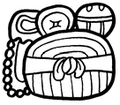| Bird Claw | |
|---|---|
| Ajaw | |
| King of Tikal | |
| Reign | 6th century |
| Predecessor | Lady of Tikal and Kaloomte' Bahlam |
| Successor | Wak Chan K'awiil |
| Religion | Maya religion |
| Signature |  |
Bird Claw, [N 1] also known as Animal Skull I and Ete I (fl. 6th century), was an ajaw of the Maya city of Tikal. The monument associated with Bird Claw is Stelae 8. [1] He carried a high-ranking name but no Tikal emblem. [2]
